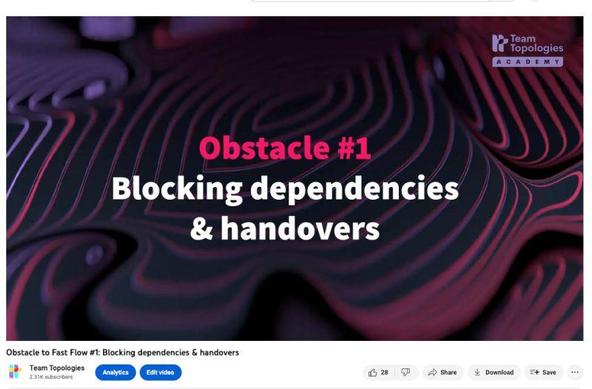🤔 Ah, the timeless art of "vibe coding" for teams. Because coding performance obviously hinges on "good vibes," not, you know, skill or logic. 🙄 Pour one out for logic and enjoy the cocktail of #buzzwords and ambiguity. Cheers to leading through vague emotional resonance! 🍸✨
https://laughingmeme.org//2025/05/25/vibe-coding-for-teams.html #vibeCoding #teamDynamics #techHumor #codingCulture #HackerNews #ngated
#teamdynamics
Hear more in the free video from the #TeamTopologies for #Managers course. https://lnkd.in/efN2CaAX
Check out the full course from Manuel Pais & Matthew Skelton on the Team Topologies Academy https://bit.ly/3Mda0lb. Seize our current offer and get 20% off using "20off-linkedin". Group discounts are available, adding extra value for teams.
🤔📈 Ah, the age-old dilemma of "When is a team too big?" 🤯 The article spends more time asking existential questions about team sizes than actually providing answers. Just like a team meeting that lasts forever but resolves nothing. 🙄🔄
https://blog.alexewerlof.com/p/when-a-team-is-too-big #teamSizeDilemma #existentialQuestions #teamMeetings #productivityChallenges #teamDynamics #HackerNews #ngated
🎁 Grab the deal now: https://bit.ly/3N3pdZG
Let’s keep learning and evolving — together. 🚀
#TeamTopologies #Training #DevOps #PlatformEngineering #SoftwareArchitecture #Leadership #TeamDynamics
Not everyone at your workplace is a friend. Do your job. Fart on people. Go home.
Featuring Chunky Laptop Skin
👉 https://istyles.com/m/laptop-workfriend
#WorkplaceHumor #OfficeLife #FunnyQuotes #WorkVibes #DayAtTheOffice #AvoidingDrama #TeamDynamics #WorkplaceRealities
Struggling with team dynamics? Be the catalyst for positive change. It starts with you. 💥 #BeTheCatalyst #TeamDynamics
HR with their espresso, Marketing with the tunes, and Tech building... PDF tools? 🤔
Stone Age Leadership: still alive.
Stop boxing humans like warehouse cats.
They're not broken robots to "fix".
They’re powerful, flawed, focused, and enough.
Your job as a leader?
🌱 Build worlds they thrive in
🧩 Form RPG squads, not clones
🔥 Growth = support, not solo quests
🫶 Reward quiet excellence
Motivation > Title. Impact > Volume.
Gardens grow. Factories burn.
#Leadership #ServantLeadership #TeamDynamics #QuietPower #PeopleNotBoxes #WorkplaceWisdom #FutureOfWork
What is the impact of different personality types in the workplace, and how can MBTI create better work environments for everyone?
Read more: https://www.careerreload.com/personality-types-in-workplace/
#MyersBriggs #PersonalityTypes #MBTI #WorkplaceCulture #TeamDynamics #Workplace
Why "Normal" Engineers Are the Key to Great Teams
https://spectrum.ieee.org/10x-engineer
#HackerNews #NormalEngineers #GreatTeams #TeamDynamics #EngineeringCulture #TalentDiversity
The 16 Myers-Briggs Personality Types in The Workplace
👉 https://www.careerreload.com/personality-types-in-workplace/
#MyersBriggs #PersonalityTypes #MBTI #WorkplaceCulture #TeamDynamics #Workplace
"Reducing handovers by having the majority of people working inside cross-functional teams with end-to-end responsibility - what we call stream-aligned teams - is key to #fastflow". Hear more on the obstacle to fast flow in this free video from the Team Topologies Distilled course 🎓 https://lnkd.in/esBz96nN
Check out the full course by Manuel Pais & Matthew Skelton, on the Academy: https://bit.ly/3glIZxR #teamdynamics #orgdesign
Explore key considerations before joining a real estate team to ensure it's the right fit for your career goals! 🤝🏠 #RealEstateCareer #TeamDynamics #LeadManagement
https://smartagentalliance.com/questions-to-ask-before-joining-a-real-estate-team/
All about teams: A new approach to organizational transformation
In today’s rapidly evolving business landscape, organizations are constantly seeking innovative ways to adapt, grow, and stay competitive. One of the most powerful tools for driving organizational transformation is the effective use of teams. This blog post will explore a new approach to organizational transformation. It will focus on team dynamics, drawing insights from industry best practices and cutting-edge research.
The Power of Teams in Organizational Transformation
Teams are the building blocks of any organization, and their effectiveness can make or break transformation efforts. Recent studies have shown that companies with high-performing teams are 2.5 times more to outperform their peers in terms of financial performance.
Empower Your Teams for Transformation
Transformation begins with people. Equip your teams with the right tools, skills, and a shared vision. This approach creates a culture of innovation and adaptability. Empowered teams drive progress, embrace challenges, and unlock new possibilities—fueling long-term growth and success. 🌟
#Empowerment #TeamTransformation #Leadership
1. Additionally, organizations that prioritize teamwork and collaboration report 21% higher profitability compared to their less collaborative counterparts.
Key Statistics on Team Effectiveness
- 75% of employers rate teamwork and collaboration as “very important”
- 86% of employees and executives cite lack of collaboration or ineffective communication for workplace failures
- Only 34% of major change initiatives achieve success
These statistics highlight the critical role that teams play in organizational success. They also reveal the challenges many companies face in fostering effective collaboration.
A New Approach to Team-Driven Transformation
To fully utilize teams in driving organizational transformation, we need a new approach. This approach should combine both online and offline strategies. Let’s explore five key strategies that can revolutionize how teams contribute to transformation efforts.
1. Cultivate a Culture of Psychological Safety
Online Method: Implement anonymous feedback tools and digital suggestion boxes to encourage open communication without fear of repercussions.
Offline Method: Conduct regular in-person “safe space” meetings. Team members can share concerns and ideas freely. Set ground rules that promote respect and openness.
Implementation Tip: Train leaders to respond positively to feedback and ideas. They should do this even if the feedback and ideas are critical. This approach reinforces the safety of speaking up.
Real-World Example: A mid-sized software development company implemented a “no-blame” policy during their weekly team meetings. They encouraged team members to share mistakes and lessons learned. This led to a 30% increase in reported issues. It also resulted in a 25% decrease in recurring bugs over six months.
2. Foster Cross-Functional Collaboration
Online Method: Utilize collaborative project management platforms that allow teams from different departments to work together seamlessly.
Offline Method: Organize cross-departmental workshops and hackathons to solve complex problems and generate innovative ideas.
Implementation Tip: Rotate team members across different projects and departments. This practice builds a broader understanding of the organization. It also fosters new connections.
Real-World Example: A retail chain created cross-functional teams. The teams comprised members from marketing, operations, and customer service. Their goal was to redesign the in-store experience. This collaborative approach resulted in a 15% increase in customer satisfaction scores. It also led to a 10% boost in sales within the first quarter of implementation.
3. Embrace Agile Methodologies
Online Method: Implement digital Kanban boards and sprint planning tools to visualize work and track progress in real-time.
Offline Method: Use physical task boards and daily stand-up meetings to promote face-to-face communication and quick problem-solving.
Implementation Tip: Start with a pilot team to test and refine agile practices before rolling out across the organization.
Real-World Example: A traditional manufacturing company adopted agile methodologies in their product development process. They broke down projects into two-week sprints. By holding daily stand-ups, they reduced time-to-market for new products by 40%. This also increased innovation output by 25%.
4. Develop a Learning Organization
Online Method: Create a digital knowledge-sharing platform where teams can document lessons learned, best practices, and innovative ideas.
Offline Method: Implement a mentorship program. This program pairs experienced team members with newer employees. The goal is to facilitate knowledge transfer and skill development.
Implementation Tip: Encourage “learning sprints” where teams dedicate time to explore new technologies or methodologies relevant to their work.
Real-World Example: A healthcare provider implemented a “Teach-Learn-Share” program. Employees spent one hour per week teaching a skill to colleagues. They either learned from others or shared insights from recent projects. This initiative resulted in a 20% increase in employee-driven process improvements. It also led to a 15% reduction in onboarding time for new hires.
5. Align Team Goals with Organizational Objectives
Online Method: Use OKR (Objectives and Key Results) software. Cascade organizational goals down to team and individual levels. This ensures alignment.
Offline Method: Conduct quarterly team retreats to review and align team goals with the organization’s strategic objectives.
Implementation Tip: Regularly communicate the “why” behind organizational goals to help teams understand their role in the bigger picture.
Real-World Example: A global non-profit organization implemented a goal-alignment system. Each team’s objectives were directly linked to the organization’s mission. This resulted in a 30% increase in project completion rates and a 25% improvement in donor satisfaction scores.
The Role of Leadership in Team-Driven Transformation
Leaders play a crucial role in enabling teams to drive organizational transformation. Research shows that transformation is 5.8 times more to be successful at organizations where leaders effectively communicate a compelling change story.
Key Leadership Strategies:
- Lead by Example: Demonstrate the collaborative behaviors and mindset you want to see in your teams.
- Empower Decision-Making: Push decision-making authority down to the team level where possible.
- Provide Resources: Ensure teams have the tools, training, and support they need to succeed.
- Celebrate Success: Recognize and reward team achievements to reinforce positive behaviors.
Overcoming Challenges in Team-Driven Transformation
While teams can be powerful drivers of transformation, there are challenges to overcome:
ChallengeSolutionResistance to changeInvolve teams in the change process from the startSilos and lack of communicationImplement cross-functional projects and communication channelsLack of clarity on goalsUse clear goal-setting frameworks like OKRsFear of failureEncourage experimentation and learning from failuresThe Impact of Local Business and Community Support
It’s important to note that team-driven transformation isn’t just for large corporations. Local businesses can also benefit from these strategies, often with even greater agility due to their size. Community support is crucial for the success of local businesses. Effective teams help these businesses serve their communities better.
For example, a local bakery can form cross-functional teams. These teams include bakers, front-of-house staff, and marketing. Their goal would be to innovate on product offerings and improve customer experience. This collaborative approach can lead to increased customer loyalty, stronger community connections, and ultimately, business growth.
Empowering Growth Through Learning
Growth thrives when individuals and organizations embrace learning as a core value. By providing opportunities for continuous skill development, fostering curiosity, and encouraging exploration, you empower people to unlock their full potential. A culture of learning not only enhances individual capabilities but also drives innovation and adaptability, ensuring sustainable success.
Conclusion
As we’ve explored in this post, teams are at the heart of successful organizational transformation. By adopting a new approach, organizations can unlock the full potential of their teams to drive meaningful change. This approach combines online and offline strategies. It fosters psychological safety, promotes cross-functional collaboration, and embraces agility. Additionally, it encourages learning and aligns goals.
As you think about your own organization’s transformation journey, consider these questions:
- How can you create an environment where your teams feel empowered to innovate and take calculated risks?
- What specific steps can you take to break down silos and promote cross-functional collaboration in your organization?
- How adopting agile methodologies improve your team’s ability to respond to market changes and customer needs?
- What opportunities exist for continuous learning and knowledge sharing within your organization, and how can you leverage them?
- How well are your team goals aligned with your overall organizational objectives? What can you do to improve this alignment?
Remember, transformation is not a destination but a continuous journey. Empower your teams and foster a culture of collaboration. Encourage innovation in your organization. This way, you can create an organization that is resilient and adaptable. Your organization will be ready to thrive in an ever-changing business landscape. The power of teams in driving organizational transformation is immense. It’s time to harness that power. Lead your organization into a successful future.
READ MORE DISCOVER MORE#AgileMethodology #BusinessInnovation #CrossFunctionalTeams #Leadership #OrganizationalTransformation #TeamDynamics #Empowerment #TeamTransformation
Last chance to save 15% on ALL @TeamTopologies Academy courses or bundles. Use WINTER2024 by EOD Jan 15th. Join us to understand operational constraints, patterns, & thinking tools to accelerate flow in your teams! #orgdesign #teamdynamics #platform #DDD https://bit.ly/3JOpX0u
Locked Up Living 186. Drew; The Moral Injury of Holding Terrifying Information: In this episode of the Locked Up Living podcast, hosts Naomi and David delve into an engaging dialogue with professional organisational consultant and executive coach, Drew. They touch upon an array of topics from the nuances of team dynamics in institutional settings, diverse career paths, to the… https://lockedupliving.podbean.com/e/drew-the-moral-injury-of-holding-terrifying-information/?utm_source=dlvr.it&utm_medium=mastodon @lockedupliving #MoralInjury #Psychotherapy #TeamDynamics #WorkplaceWellness #PersonalGrowth
As the year winds down, it’s the perfect moment to reflect on the past and start setting goals for the year ahead. Why not make learning and growth a part of your resolutions? 🚀
Explore the Team Topologies Academy courses and bundles to deepen your understanding of #TeamTopologies concepts, #TeamDynamics, #PlatformAsAProduct, #ValueStreams, enabling #EffectiveTeams, and much more.
Let’s make next year a year of learning and progress! 💡 Get 15% off using "winter2024" https://bit.ly/3N3pdZG
Nobody likes to be told, especially not a group. If something does not add up for you, just ask a question that makes it visible. If it makes it funny, that might help.
If you are right, people need a moment to adjust. If you are wrong, the question helps you and others to learn something new.






